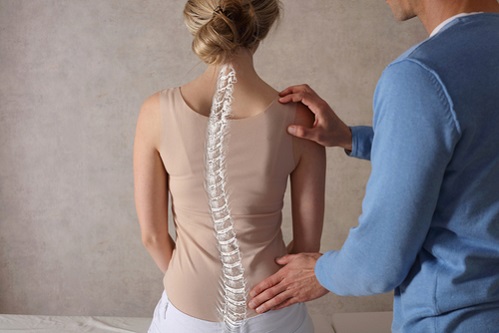The size and shape of a normal spine vary. Nobody’s spine is perfectly straight. Normal spine curvature helps the body distribute weight evenly and absorb movement shocks.
But spinal deformities occur when the spine bends or twists in an abnormal way. This can happen for many reasons. Minor spinal abnormalities may merely necessitate condition monitoring. More severe cases, on the other hand, may require conservative therapy or perhaps surgery.
Diagnosing Spinal Deformities
If you suspect that you have a problem with your spine, you should see a doctor. They will conduct a thorough medical history and physical exam to evaluate the source and severity of your spine problems. Diagnostic tests are frequently conducted so doctors can get a good picture of your spine issues. They may prescribe you to do:
- X-ray: Image of the vertebral column that can reveal arthritis, fractures, bone spurs, or vertebral slippage.
- Computed Tomography (CT) Scan A noninvasive X-ray procedure that uses a computer to create a 2-dimensional picture of your spine. The CT scan is important for the detection of alterations to the bone structures of the spine.
- Magnetic Resonance Imaging (MRI): MRIs, unlike X-rays, may identify disc and ligament damage by employing a magnetic field and radiofrequency waves. This provides a clearer picture of your condition and aids in assessing any spinal cord injuries.
- Myelogram: This specialist X-ray uses contrast dye in the spinal canal. The imaging allows surgeons to see the spinal cord and nerves in great detail. This is useful for evaluating nerves that have been squeezed by a disc, bony overgrowths, or stenosis.
- Bone Density Test: It can measure the strength of your vertebrae and detect any bone loss.
Conservative Treatments
Your doctor will suggest treatments to aid with symptoms and cure spinal abnormalities after a comprehensive exam and appropriate diagnosis. Those with mild or moderate illnesses usually simply require symptom management. Conservative therapies include the following:
Pain Management
Pain in the back can be relieved with over-the-counter or prescription pain relievers. Aspirin and ibuprofen are examples of nonsteroidal anti-inflammatory medicines (NSAIDs) that can reduce inflammation and give pain relief. Steroids can also assist in alleviating nerve discomfort and edema. Narcotics relieve severe pain, but the risk of addiction must be addressed. Cortisone injections can help with joint arthritis and minor nerve compression.
Physical Therapy
A physical therapist can teach you exercises and stretches to strengthen the muscles that support the spine and other damaged areas. It will improve flexibility, range of motion, and balance in your body.
Scoliosis Brace
Bracing is often beneficial to children with scoliosis because it promotes correct spine growth. Adults may benefit from the use of a brace to alleviate pain. However, the abnormality will not be corrected because their spines have developed.
Surgical Treatments
If conservative therapy does not relieve your pain or your disease is so severe that it interferes with your quality of life, spinal deformity correction surgery may be the next step. The purpose of surgery is to stabilize the spine in the deformed area.
An orthopedic surgeon will add tiny pieces of bone, known as bone grafts, to the afflicted area during a posterior fusion. This helps your vertebrae to develop together and re-align them. The clinician may also use metal rods, screws, hooks, or wires to help keep the spine in position for appropriate fusion. The spine will not be able to curve unnaturally after three to twelve months of recuperation time.
The surgeon may choose to perform the same treatment through an incision around your ribs in the front of your body. This is referred to as an anterior fusion.
A spinal osteotomy can help to rectify alignment in some circumstances. This surgery restores normal vertebral placement by removing a section of the vertebra.







